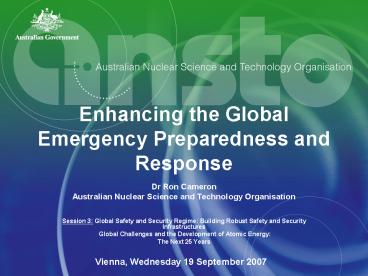Enhancing the Global Emergency Preparedness and Response - PowerPoint PPT Presentation
Title:
Enhancing the Global Emergency Preparedness and Response
Description:
Enhancing the Global Emergency Preparedness and Response – PowerPoint PPT presentation
Number of Views:18
Avg rating:3.0/5.0
Title: Enhancing the Global Emergency Preparedness and Response
1
Enhancing the Global Emergency Preparedness and
Response
- Dr Ron Cameron
- Australian Nuclear Science and Technology
Organisation - Session 3 Global Safety and Security Regime
Building Robust Safety and Security
Infrastructures - Global Challenges and the Development of Atomic
Energy - The Next 25 Years
Vienna, Wednesday 19 September 2007
2
The hazard balance
Prevention
Protection
Detection
Emergency response
Response
HAZARD
3
Outline of the presentation
- The threat environment
- The role of the IAEA
- The challenges in ensuring appropriate emergency
arrangements - Opportunities for enhancements of these
arrangements - Conclusions
4
Threat environment
- Lack of political or economic stability in some
countries raises concerns about control of
radioactive materials - With the current and projected demand for
nuclear power, more countries will need enhanced
emergency planning, preparedness and response
capability to deal with the potential for a
nuclear reactor accident.
5
Nuclear and radiological threats can arise from
- worldwide use of radioactive material
- problems with control over radioactive sources
leads to the possibility of acquisition of
nuclear and radiological material - illicit trade in nuclear technology
- Illicit trafficking 149 events in 2006,15
involved seizure of material from illegal groups
6
Nuclear and radiological threats can arise from
- clandestine nuclear programmes
- sophisticated extremist groups
- use or threatened use of radiological dispersal
devices
7
Role of the IAEA
- The IAEA works to assist countries through
- training courses
- safety standards and guidance material
- emergency exercises
- running an incident and emergency centre (170
notifications and some 25-30 events per year) - reviews of national systems EPREV
- being a trusted source of information to media,
governments etc
8
Enhancing Mutual Assistance
- IAEA Response Assistance Network (RANET)
- Joint Radiation Emergency Plan of the
International Organisations - International Action Plan for Strengthening the
International Preparedness and Response System
for Nuclear and Radiological Emergencies - IAEA Regional Projects to Strengthen Response to
Radiological and Nuclear Emergencies - National Competent Authority Consultative Group
9
IAEA has taken lead in international collaboration
- Early Notification Convention - 100 MSs
- Mutual Assistance Convention 98 MSs
- Coordination between International Organisations
- Information gathering and dissemination
10
But more needs to be done
11
Beyond the conventions
- There is a need to
- Ensure greater MS commitment to GS-R-2, as the
fundamental safety standard in this area - Increase the status of ENATOM to ensure wider
implementation, currently as a guidance document
it does not have high status - Close the gap in the Conventions, by agreeing
reasonable thresholds for notifications with
respect to radiological incidents accidental or
malicious acts. - Consolidate emergency planning arrangements.
12
Capacity Building - in country
- Full ability to respond to nuclear and
radiological emergencies in their country - Bi-lateral, regional or international
collaboration RANET? - Resources and effective training
13
Capacity Building - in country
- Emergency responders must be able to make
accurate radiation measurement in field
conditions. - Countries need to adopt and put into their
planning agreed international reference levels. - First responders such as fire fighters, police
and ambulance personnel must be trained to a
level that they can act immediately without
having to wait for advice from radiation experts - Each country needs to have access to trained,
up-to-date, radiological assessors to advise
first responders and reconfirm initial findings .
14
Communication
- There must be robust communication channels that
go beyond emergency personnel and technical
experts. - Appropriate education should be provided to all
levels of society prior to an event. - Steps should be taken to increase the ability of
national decision-makers, civil defence personnel
and communicators to place nuclear and
radiological threats in context. - More focus on the non-technical facets of
emergency response, especially decision-making by
politicians and communication to the media and
the public.
15
Enhancing the International Action Plan
Where to from here?
16
Conclusion
- With the evolving threat, emergency planning
remains a key component of response to incidents
and accidents - Currently there are enhancements needed in the
implementation of these arrangements and also
lack of integration of mechanisms and documents
that cover the arrangements - Opportunities exist to make better use of the
resources made available by the Agency and to
enhance the capability in Member States - All Member States need to consider their
commitment to, and support of, emergency
arrangements, both nationally and regionally






![About Nuclear, biological, and chemical [NBC] Attack? PowerPoint PPT Presentation](https://s3.amazonaws.com/images.powershow.com/10003306.th0.jpg?_=20240224121)
























